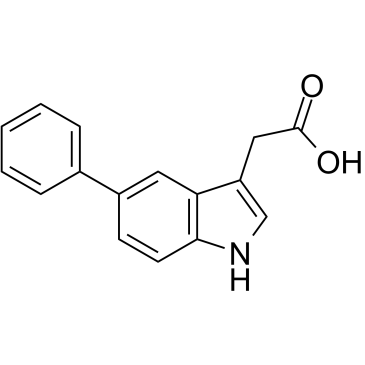5-Ph-IAA |
| Catalog No.GC61525 |
5-phenyl-indole-3-acetic acid (5-Ph-IAA) is a derivative of IAA.
Products are for research use only. Not for human use. We do not sell to patients.

Cas No.: 168649-23-8
Sample solution is provided at 25 µL, 10mM.
5-phenyl-indole-3-acetic acid (5-Ph-IAA) is a derivative of IAA. 5-Ph-IAA is a ligand to establish the auxin-induced degron 2 system (AID2) together with the OsTIR1 (F74G) mutant. Using AID2, degron fusion proteins can now be more precisely controlled, enabling target protein degradation with a half-life of 10 to 45 minutes by adding low doses of 5-Ph-IAA [1]. 5-Ph-IAA shows higher affinity to AtTIR1(F79G).
The mAID-fused targets were rapidly degraded by the addition of 1 μM 5-Ph-IAA and showed significant tumour suppression of mAID-BRD4 xenografts at all doses of 5-Ph-IAA treatment including 0, 1, 3, 10 mg/kg [1]. The treatment with 50 mM 5-Ph-IAA caused a rapid decrease in fluorescence intensity in many embryos (78%, 18/23 embryos), but 5 mM 5-Ph-IAA did not. 5-Ph-IAA can be used for loss-of-function experiments in C. elegans embryos, although treatment with 5-Ph-IAA is not always effective, possibly because the C. elegans embryo develops within the eggshell, which blocks its permeability to many compounds [2].
References:
[1].Yesbolatova A, Saito Y, Kitamoto N, Makino-Itou H, Ajima R, Nakano R, Nakaoka H, Fukui K, Gamo K, Tominari Y, Takeuchi H, Saga Y, Hayashi KI, Kanemaki MT. The auxin-inducible degron 2 technology provides sharp degradation control in yeast, mammalian cells, and mice. Nat Commun. 2020 Nov 11;11(1):5701.
[2].Negishi T, Kitagawa S, Horii N, Tanaka Y, Haruta N, Sugimoto A, Sawa H, Hayashi KI, Harata M, Kanemaki MT. The auxin-inducible degron 2 (AID2) system enables controlled protein knockdown during embryogenesis and development in Caenorhabditis elegans. Genetics. 2022 Feb 4;220(2):iyab218.
Average Rating: 5 (Based on Reviews and 3 reference(s) in Google Scholar.)
GLPBIO products are for RESEARCH USE ONLY. Please make sure your review or question is research based.
Required fields are marked with *




















